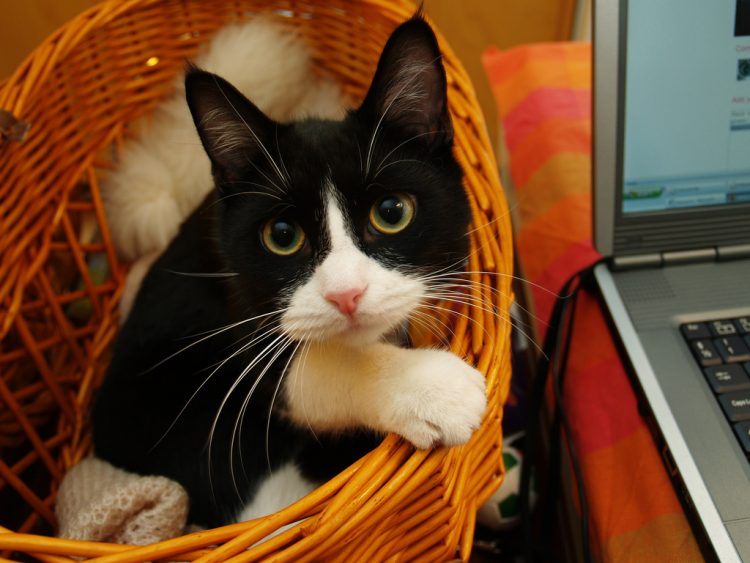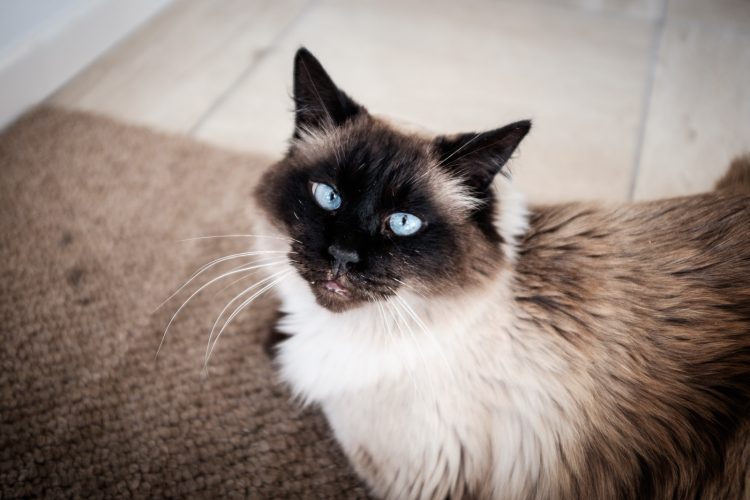
Sometimes we really need to know the answers to burning questions.
I don’t know about you, but mine are:
- Why do some cats have white paws?
- Why do black cats turn rust-colored with age?
- Why does the fur grow back darker when you clip a colorpoint cat?
You want answers? Then stay tuned for some tremendous trivia about cats and their coat color.
Tuxedo Cats
There is a special place in my heart for tuxedo cats. My first cat, Skate, was a dockyard cat rescue and a handsome tuxedo kitten. But have you ever, ahem, paw-sed to wonder why so many cats have white paws or a white stripe down their middle? And why do you never see a cat with a white stripe along her spine?
The answer? How kittens develop in the womb determines their color patterns.
Coat color is due to pigment in the hair shafts, and white hairs lack pigment. In the womb, the kitten starts off as a ball of cells that divide repeatedly. Pigment cells are made near the spinal cord and migrate over the surface of the skin to cover the body (isn’t that cool?).
Now think where the paws are in relation to the spine (i.e., the most distant point), and you unravel the puzzle. To reach the paws, tail tip, belly and brisket, those pigment cells have to travel a long, long way. In some cases, they stop and never complete the journey, leaving the extremities lacking in color.
This is why you never see a white stripe along the spine — because that’s where pigment cells were born.

Black Cats and Rusty Fur
An interesting quirk of nature is that some black cats turn rust-colored with age. My mother-in-law’s cat was like this, a black fluff ball in younger life that turned ginger in his dotage.
This color change is down to an amino acid called tyrosine, an essential building block of the pigment molecule melanin. If the cat is deficient in tyrosine, then she can’t make melanin, and the rich coat color starts to fade.
The cat makes tyrosine from another amino acid called phenylalanine. If the enzyme to do this is lacking, pigment can’t be produced, which is what happens with albino animals whose coat, skin and eyes remain colorless or pink.
Cats need a certain amount of phenylalanine and tyrosine in the diet to maintain a deep, rich black color. If their diet is lacking, or in older cats the bowel wall thickens and stops absorbing nutrients, then the cat becomes deficient and turns from black to rust-colored.
The good news? The process is reversible with a dietary supplement or when the bowel disease is treated. But before you give a tyrosine supplement to a “faded” cat, know that other problems can also cause the coat to fade, such as copper deficiency or too much zinc in the diet (which then triggers copper deficiency), so get a diagnosis from your vet first.
Also, tyrosine makes thyroid hormone, so it could aggravate a cat with overactive thyroids. Cats with liver disease or a malignant melanoma should never be given additional tyrosine — it will worsen their condition. Again, check with a vet.
Check out Bruce the kitty’s coat color journey from fuzzy gray to jet black:

Colorpoint Cats and Color Change
If you have a Siamese, Balinese or Birman, then you may know that when a patch of hair is clipped off (for example, when a female is desexed), the fur grows back darker. In fact, why should the nose and ear tips be dark when the body is pale?
The enzyme in these cats helps make coat color sensitive to heat. The enzyme tyrosinase converts tyrosine to melanin, but tyrosinase is damaged by heat. The more the body heats up, the less tyrosinase is produced, and less pigment produced. Thus the warmer parts of the body are pale, while the cooler parts are darker.
When a patch of fur is clipped, the skin is cooler and the hair follicles produce more pigment. This is also why color points are colored in the first place. Think about it. Ear tips, noses, tails and paws are all extremities and therefore away from the heat of the body. While the hot body is creamy or white in color, those cool extremities become pigmented.
So now when someone asks, “Why do black cats turn rusty?” you can tell them the answer.
This pet health content was written by a veterinarian, Dr. Pippa Elliott, BVMS, MRCVS. It was last reviewed Oct. 13, 2018.



